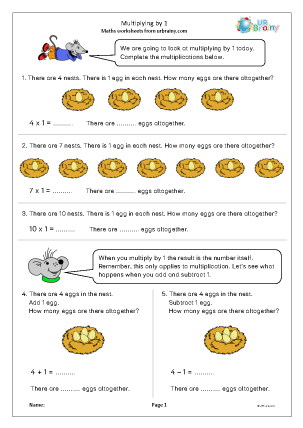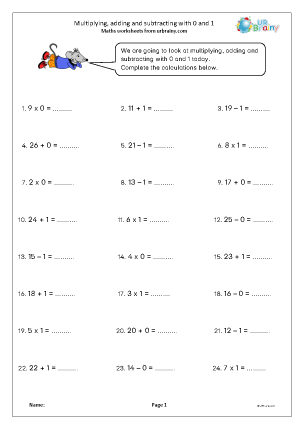Multiplication
Year 4 is the year that children are expected to have got to grips with all the times tables and learned them ‘off by heart’. In particular this means learning those not covered in previous years; the 6x, 7x and 9x tables as well as the 11x and 12x tables. Of course these also happen to be the hardest to learn!
We have plenty of excellent practice material for all these tables, but children really do need to be able to recite them quickly and correctly. The better they know these tables the quicker they will be able to answer accurately and move on to successful written methods of multiplication and division. We have over 50 pages of tables worksheets, including going up to 12 x 12 so why not take a look now?
Multiplying by 10, 100 and 1000 are fundamental ideas in arithmetic. These ideas will eventually be used in work involving negative numbers, positive numbers, decimals and percentages, so it is very important to master them early on.
Never say 'to multiply by ten we add a nought'. This idea certainly works for whole numbers and is a nice quick explanation, but is totally false for decimals.
e.g. 3.98 x 10 is definitely not 3.980!
If children are taught to ‘add a nought’ there will be a great deal of un-learning needed later on. Bad habits are very difficult to break.
The ideas to get across are as follows:
Multiplying:
When multiplying by 10 the number moves one place to the left.
When multiplying by 100 the number moves two places to the left.
When multiplying by 1 000 the number moves three places to the left.
Revising tables and multiplication
A look at tables learned earlier, including 2x, 5x and 10x tables. Using knowledge of these tables.
Learning the 6x table: six first (eg 6 x 8)
Worksheets to help children learn the six times table 'off by heart', with the six coming first: eg 6 x 5 = 30 or 6 x 8 = 48
Learning the x6 table: six second (eg 8 x 6)
Worksheets to help children learn the six times table 'off by heart', with the six coming second: eg 2 x 6 = 12 or 8 x 6 = 48
More 6x table practice
Further activities on the six times table, including bar modelling to help children learn the table ‘off by heart’.
These resources can also be found in our Times Tables category.
Learning the 7x table: seven first (eg 7 x 8)
Worksheets to help children learn the seven times table 'off by heart', with the seven coming first: eg 7 x 5 = 35 or 7 x 8 = 56
Learning the x7 table: seven second (eg 8 x 7)
Worksheets to help children learn the seven times table 'off by heart', with the seven coming second: eg 2 x 7 = 14 or 8 x 7 = 56
More 7x table practice
Further activities on the seven times table, including bar modelling to help children learn the table ‘off by heart’.
These resources can also be found in our Times Tables category.
Learning the 9x table: nine first (eg 9 x 8)
Worksheets to help children learn the nine times table 'off by heart', with the nine coming first: eg 9 x 5 = 45 or 9 x 8 = 72
Learning the x9 table: nine second (eg 8 x 9)
Worksheets to help children learn the nine times table 'off by heart', with the nine coming second: eg 2 x 9 = 18 or 8 x 9 = 72
More 9x table practice
Further activities on the nine times table, including bar modelling to help children learn the table ‘off by heart’.
These resources can also be found in our Times Tables category.
Learning the 11x table: eleven first (eg 11 x 8)
Worksheets to help children learn the eleven times table 'off by heart', with the eleven coming first: eg 11 x 5 = 55 or 11 x 8 = 88

Introduction to the 11x table up to 11 x 12.
Learning the x11 table: eleven second (eg 8 x 11)
Worksheets to help children learn the eleven times table 'off by heart', with the eleven coming second: eg 2 x 11 = 22 or 8 x 11 = 88
More 11x table practice
Further activities on the eleven times table, including bar modelling to help children learn the table ‘off by heart’.
These resources can also be found in our Times Tables category.
Learning the 12x table: twelve first (eg 12 x 8)
Worksheets to help children learn the twelve times table 'off by heart', with the twelve coming first: eg 12 x 5 = 60 or 12 x 8 = 96
Learning the x12 table: twelve second (eg 8 x 12)
Worksheets to help children learn the twelve times table 'off by heart', with the twelve coming second: eg 2 x 12 = 24 or 8 x 12 = 96
More 12x table practice
Further activities on the twelve times table, including bar modelling to help children learn the table ‘off by heart’.
These resources can also be found in our Times Tables category.
Fast mental recall of tables
More to encourage rapid recall of times tables.

Even more 'tables' practice.
Multiplying by 0 and 1
A look at multiplying, adding and subtracting with zero or one.
Written methods of multiplication
Developing the formal written method of long multiplication.
Further multiplication: multiples, factors and products
Introducing multiples, factors and the term product.


































































































